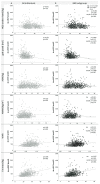Dp-ucMGP as a Biomarker in Sarcopenia
- PMID: 36558558
- PMCID: PMC9785709
- DOI: 10.3390/nu14245400
Dp-ucMGP as a Biomarker in Sarcopenia
Abstract
Sarcopenia is linked with an increased risk of falls, osteoporosis and mortality and is an increasing problem for healthcare systems. No satisfying biomarkers for sarcopenia diagnosis exist, connecting bone, fat and muscle. Matrix-GLA-protein (MGP) is an adipokine that regulates bone metabolism and is associated with decreased muscle strength. Associations of dp-ucMGP were analyzed in the BioPersMed cohort (58 ± 9 years), including 1022 asymptomatic subjects at moderate cardiovascular risk. Serum measurements of dp-ucMGP in 760 persons were performed with the InaKtif MGP Kit with the IDS-iSYS Multi-Discipline Automated System. DXA data (792 persons) measured with the Lunar iDXA system and physical performance data (786 persons) were available. Dp-ucMGP plasma levels correlate with sarcopenia parameters like gait speed (ρ = −0.192, p < 0.001), appendicular skeletal muscle mass (ρ = 0.102, p = 0.005) and appendicular skeletal muscle mass index (ρ = 0.112, p = 0.001). They are lower in persons with sarcopenia (p < 0.001) and higher in persons with reduced physical performance (p = 0.019). Persons in the lowest dp-ucMGP quartile have the highest risk for reduced muscle mass, decreasing with each quartile, whereas persons in the highest quartile have the highest risk of reduced muscle strength. Dp-ucMGP might be a good biomarker candidate in sarcopenia characterization.
Keywords: BioPersMed cohort; biomarker; dp-ucMGP; sarcopenia.
Conflict of interest statement
The authors declare no conflict of interest.
Figures




References
-
- Akune T., Muraki S., Oka H., Tanaka S., Kawaguchi H., Tokimura F., Yoshida H., Suzuki T., Nakamura K., Yoshimura N. Incidence of certified need of care in the long-term care insurance system and its risk factors in the elderly of Japanese population-based cohorts: The ROAD study. Geriatr. Gerontol. Int. 2013;14:695–701. doi: 10.1111/ggi.12155. - DOI - PubMed
MeSH terms
Substances
Grants and funding
LinkOut - more resources
Full Text Sources
Miscellaneous

